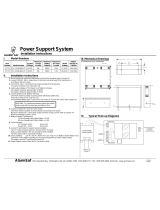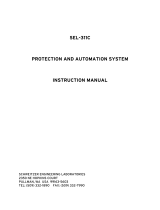Page is loading ...

Ultra Timers
UT-10 & UT-20 Installation Instructions
Operational Specifications:
Timing: 1 to 620 Seconds
Voltage: 12 - 24VDC/VAC
Voltage Selection: 12VDC: Factory Preset 24VDC: Cut Red Jumper (W2)
12VAC: Cut White Jumper (W1) 24VAC: Cut Red and White Jumper (W1,W2)
Current: 12 Volts Relay inactive: 9mA
Relay active: 65mA
24 Volts Relay inactive: 28mA
Relay active: 102mA
Relay Contacts:
Ratings: 5 Amp @ 24VDC
5 Amp @ 120VAC
LED Indicator:Red LED illuminated when relay is active
+
_
T GND R NO C NC
W1
AC
WHITE
24V
RED
W2
UT-10
S2
4
1
1
8
S1
BASE
TIME
ON
ON
+
_
T GND R NO C NC
W1
AC
WHITE
24V
RED
W2
UT-20
S2
1
8
S1
BASE
TIME
ON
ON
1
8
PULSE
WIDTH
OffOffOffDual Delay
OffOnOffDelayed Operate
-OffOnDelayed Release
OnOnOnOne Shot
S1-8S1-7S1-6Mode
UT-10 Mode Selection
UT-20 Mode Selection
AlarmSaf 65A Industrial Way Wilmington, MA 01887-3499 (978) 658-6717 FAX: (978) 658-8638 Web Site: www.alarmsaf.com
OffOnOffOnOffOnDelayed Pulse
OffOnOnOnOffOnDouble Pulse
OnOffOffOffOffOffDual Delay
OnOffOffOffOnOffDelayed Operate
OnOffOff-OffOnDelayed Release
OnOffOffOnOnOnOne Shot
S2-
7
S2-
6
S2-
5
S1-
8
S1-
7
S1-
6
Mode
Terminal Legend:
+ : Positive Input Power R : Reset
- : Ground NO : Normally Open Contact
T : Trip C : Common Contact
GND : Ground NC : Normally Closed Contact
Note: Terminals 2 & 4 (Ground) are internally connected
52-093
091996
The timer mode is selected with
the following switches:
The timer mode is selected with
the following switches:
Mode Configuration
Trip Terminal (T)
vTimer may be configured for a positive or negative trip signal.
}Positive Trip: S2-1 ON (Default Setting)
}Negative Trip: S2-1 OFF
Retriggering
vRetrigger Mode:
}S1-8 OFF. Repeated applications of valid trip signal, applied during timeout, will extend timing.
vNon-Retrigger Mode:
}S1-8 ON. Repeat applications of a trip signal, applied during timeout, will not affect timing.
Reset Terminal (R)
vReset is used to cancel the operation of the timer.
vUpon application of a valid reset signal, timing ceases and the output contacts return to their originaal
position.
vThe timer may be configured for reset to operate on a positive or negative reset signal.
vTo use the reset terminal, S2-4 (Reset Enable Switch) must be OFF.
}Reset Disabled: S2-4 ON (Default Setting)
}Positive Reset: S2-2 ON (Default Setting)
}Negative Reset: S2-2 OFF
vNote: When not using the reset terminal S2-4 should be ON.
Maintained Reset
vThe reset terminal may be used to override or block a trip signal.
vWhen S2-3 is ON, a continuous signal applied to the reset terminal will cause the timer to remain in reset
mode and ignore all trip signals.
Time Set Instructions
Pulse Width Adjustment
vOn the UT-20 only, the pulse width is adjustable for the Double Pulse and Delaed Pulse functions.
vThe pulse width (P) is adjustable from 1 to 220 seconds by turning the Pulse Width potentiometer.
Base Time Adjustment
vTiming is adjusted using the time set switches (S1-1 through S1-5) in conjunction with the Base Time
Potentiometer.
vThe Base Time adjustment is adjustable from 1 to 20 seconds. This establishes a starting point for the time set
switches as follows:
}Set the time set switchs for a value of 1 (S1-1 = ON, S1-2 through S1-5 = OFF).
}Adjust the Base Time Potentiometer for a particluar time. This is the Base Time.
vS1-1 through S1-5 are time multipliers valued as follows: S1-1 has a value of 1, S1-2 = 2, S1-3 = 4, S1-4 = 8
and S1-5 = 16. These are selected by placing them in the ON position. The sum of the individual switch values
selected equals their total value.
}
160S1-5
80S1-4
40S1-3
20S1-2
10S1-1
ON ValueOFF ValueSwitch
Maximum Total Value if S1-1
through S1-5 are ON = 31.

UT-10 & UT-20
One Shot
Upon application of a trip signal, the output
contacts transfer and the time delay begins. After
the delay period the contacts return to their
original position.
+
0
TRIP
OUTPUT
DELAY
DELAY
POSITIVE
TRIP
TRIP
NEGATIVE
Dual Delay
Dual Delay is a combination of Delayed Operate
and Delayed Release. Upon application of a trip
signal, the time delay begins. At the end of the
time delay, the output contacts transfer and hold.
Upon removal of the trip signal, the time delay
begins again. After the delay period, the output
contacts return to their original position.
DELAY DELAY
+
0
TRIP
OUTPUT
Delayed Operate
Upon application of a trip signal the time delay
begins. At the end of the time delay the output
contacts transfer and hold until the trip signal is
removed. The trip signal MUST remain for the
entire length of the delay for the contacts to
transfer. Removal of the trip signal prior to
time-out will cancel the operation of the timer.
+
0
TRIP
OUTPUT
DELAY
POSITIVE
TRIP TRIP
NEGATIVE
DELAY
Delayed Release
Upon application of a trip signal, the output
contacts transfer. The time delay begins upon
REMOVAL of the trip signal. After the delay
period, the output contacts return to their original
position. Re-application of a trip signal during
timing will extend the delay.
DELAY
+
0
TRIP
OUTPUT
UT-20 Only
Double Pulse
Double Pulse is defined as a one-shot with
adjustable pulses (P) at each end. Upon
application of a trip signal, the output contacts
will transfer for a period determined by the
Pulse Width Potentiometer (0 to 220 sec.). At
the end of the programmed delay, the output
contacts transfer again for the period already
determine by the Pulse Width Potentiometer.
+
0
TRIP
OUTPUT
DELAY
P P
0
TRIP
OUTPUT
DELAY
P P
+
Note:
The programmed delay is determined by the
combination of the Base Time Potentiometer
and the Time Set switches. See the timing
adjustment paragraph for more information.
Delayed Pulse
Upon application of a trip signal, the
programmed delay begins. After the
programmed delay period, the output contacts
transfer for a period of time (P) determined by
the Pulse Width Potentiometer.
+
0
TRIP
OUTPUT
DELAY
P
0
TRIP
OUTPUT
DELAY
P
+
AlarmSaf 65A Industrial Way Wilmington, MA 01887-3499 (978) 658-6717 FAX: (978) 658-8638 Web Site: www.alarmsaf.com
Time Set Instructions (continued)
The base time is multiplied by the total value of the time set switches to arrive at the desired delay time. The time set
switches can be combined to form any integer value from 1 to 31. The time delay equals the Base Time multiplied by
the total value of the time set switches.
Timing Formula
The following formulas can be used to calculate the Base Time pot and switch settings:
BASE TIME X TOTAL SWITCH VALUE = DESIRED DELAY TIME
(Set by Potentiometer) (Set by Time Set Switches)
Therefore, to set the TOTAL SWITCH VALUE for a particular delay time:
TOTAL SWITCH VALUE = DESIRED DELAY TIME / BASE TIME
Timing Example
The desired delay time is 60 seconds. Set the time set switches to a value of 1 in order to set the base time. This
corresponds to S1-1 ON, S1-2 through S1-5 OFF. Now adjust the Base Time Potentiometer (BTP) for the selected
delay (see Timing Formula). In this case, a base time of 6 seconds and multiplier (switch value) of 10 was selected, so
the BTP should be set for 6 seconds. Now change the time set switches to a value of 10. This corresponds to S1-1, S1-3
and S1-5 OFF; S1-2 and S1-4 ON. The timer is now set for a delay of 60 seconds.
Sample Chart for Delay Times
OnOnOnOnOn3120 X620 =
OffOnOffOnOff106 X60 =
OffOnOffOffOn96 X54 =
OffOnOffOffOff86 X48 =
OffOffOnOnOn76 X42 =
OffOffOnOnOff66 X36 =
OffOffOnOffOn56 X30 =
OffOffOffOnOff212 X24 =
OffOffOffOffOn118 X18 =
OffOffOffOffOn112 X12 =
OffOffOffOffOn16 X6 =
(16)(8)(4)(2)(1)
S1-5S1-4S1-3S1-2S1-1
Total
Switch
Value
Base Time
(Seconds)
Desired
Time
(Seconds)
Timing Formula Time Set Switches (Values)
Troubleshooting Guide
vNo Relay Operation
}Verify that the correct input voltage is applied at terminals #1 and #2
}Verify that the correct jumpers are cut for the applied input voltage
}Test relay by setting up timer as a ONE-SHOT - set for minimum delay
}Verify relay transfer by checking output terminals with an ohmmeter
vImproper Relay Operation
}Verify that the proper switch settings have been selected
vFor Further Assistance
}
Call the
AlarmSaf
Technical Assistance Department
/







